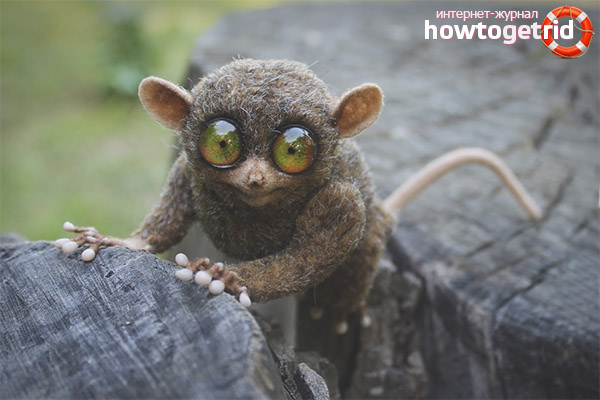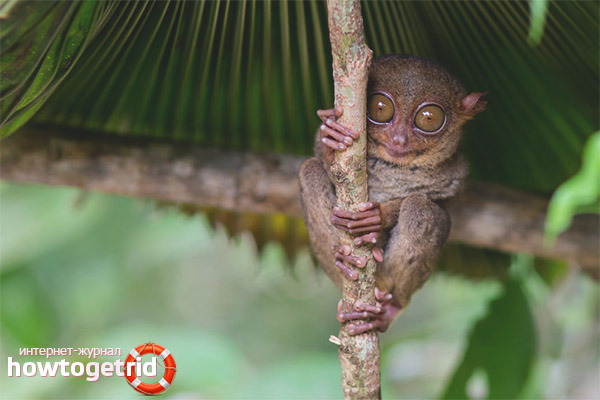The content of the article
An unknown animal is a definition coined by A.S. Pushkin, very accurately said about the tarsier - a tiny monkey from the primates. And the size, and appearance, and even the structure of the legs - everything in it surprises and delights. Here, obviously, nature did not skimp on fantasy, or maybe it is an alien resident who came to Earth by accident, because he has many unique abilities that other living creatures do not possess.
View description
The animal is so small that it easily fits in the palm of an adult male. Their growth is from 10 to 16 cm, the length is measured from the crown to the tail. But the tail is so long that sometimes it exceeds the growth by 2 times. Weight does not exceed 130 - 160 gr. As expected, males weigh more.
Tarsiers have rather long paws, but the hind legs are larger to make it easier to push off and fly a few meters. The jumps of these miniature animals are graceful and swift. All their limbs are equipped with very long fingers - 5 on each, with sharp claws. On the fingers there are thickenings that help to climb a tree and descend without problems.
The head is disproportionate to the body, as it is very large. What is surprising: it connects to the spine vertically, and this allows the animal to rotate its head almost 360 degrees. Tarsiers can also have large ears, but these are not all their advantages. The hearing of this primate is so sharp that it can recognize sounds whose frequency is over 90 kHz. Scientists have found that tarsiers have a very significant amount of brain, because the head is so big.
The eyes of the tarsier are perhaps its most striking distinguishing feature, since with very small sizes of the animal they have a diameter of 16 mm and are larger than the volume of its brain. Eye color is yellow. The pupils are very small, but in the dark, when it is time for hunting, they begin to grow and glow, which always causes local residents involuntary mystical fear. But thanks to these properties, the vision in this primate is excellent.
The whole body is covered with wool, which can be brown or grayish brown. It all depends on the species to which this tarsier belongs. There is no wool on the ears and tail.
Habitat
Based on research, scientists were able to determine that these animals live on the planet for several million years. However, if earlier European and Asian parts, some territories of North America could be considered their native meta, now the habitat has narrowed significantly, and to meet these unusual animals, you should go to the distant Philippine Islands, to Sumatra or Borneo. But even there the number of animals is gradually reduced, and above all, people can be called guilty of this. Due to the passion for profit, tarsiers are caught for sale, and also cut down forests where these animals are used to living.
Their habitat is the densest part of the forest, where there is a large cluster of trees. It is here that the whole life of tarsiers flows, and for this reason they can only be seen if you are very lucky. They are very careful, know how to hide perfectly in dense foliage or hollow tree, in addition, lead a nocturnal lifestyle. It’s easy to crawl along the trunk and branches, but even if you need to quickly hide from the enemy or catch the victim, he can jump almost 1.5 meters in height, and even more in length. Perhaps, in sports, he would give odds to any athlete.
Animals move through the tree by jumping, and the tail also participates in the movement, performing the functions of balancing. Down on the soil, they rarely go down, they are more comfortable to be in the trees.
In a day, a miniature tarsier can cover a distance of about 500 meters, protecting its territory.If violators of its borders appear, the owner of the territory announces his dissatisfaction in this way: he emits a very thin piercing squeak, and then it becomes clear to uninvited visitors that it is time to leave. An interesting fact is that a person is not able to hear these sounds, since he can perceive sounds no more than 20 kHz, and the animal emits sound signals at a frequency of 70. A much more peaceful communication between individuals occurs at the same frequency.
Hunter with luminous eyes
Tarsiers prefer this way of life: to sleep during the day, and to be awake and active at night. Glowing eyes help them a lot in this. They like lanterns help to find the victim, which is time to eat.
Since the animal does not recognize any plant food, it belongs to the family of predators, and the hunter is very professional, has dexterity and quick reaction. The remaining monkeys, in addition to animal food, also eat plant matter.
Night hunting tarsiers is, first of all, an organized ambush. The animal takes a wait-and-see attitude, freezes and patiently hides. When a victim appears, he is in no hurry to catch her. Only when there is a distance of one jump, tarsier jumps, making a powerful throw, and leaning its mass on top, instantly stuns and eats its lunch.
The basis for feeding this species of primates are various insects and very small representatives of vertebrates. These are most often bugs and grasshoppers, which immediately lose their heads due to the sharp teeth of the animal. The victim caught in the hunt is tarsely held in tenacious paws. To get enough, he needs to eat about 10 percent per day. from own weight. The most delicious dish for him is always the locust, but also small birds and tree lizards may turn out to be lunch.
But these animals become objects of hunting for many birds of prey, and first of all, the worst enemy is the family of owls.
Reproduction of the genus
Tarsiers prefer to live alone, having their own designated small territory. For a female, this place is determined in 2 hectares, males require several times more. But the beginning of December is usually marked by great activity, since at this time a rush begins at these animals, the decline of which is noted at the end of January.
Males are very unstable, and during this time they manage to find several brides for mating. But since one female can give birth to only one cub, to continue the population this is the best option.
The bearing of the fetus lasts 6 months. Mom does not hide places for the birth and maintenance of the cub, because he will always be with her. The male does not take part in raising his own children.
A baby is already born savvy. He tenaciously clasps his mother's paws on his stomach, and now will accompany her inseparably everywhere. Just born babies weigh no more than 30 grams. During the first few months, they feed only on breast milk. Then the predatory instincts are revealed, and a sweet, affectionate child begins to feed, like his mother.
Scientists were able to determine that the average life expectancy of this animal is 10 - 13 years. Since this species is equated to disappearing, conservationists are sounding the alarm about this, and the Philippine authorities are trying to create the most comfortable conditions for these animals. There is even a special official center specializing in the conservation of these primates.All favorable conditions for their living and reproduction of the clan are created here.
However, these animals do not tolerate confined spaces, and in captivity they die very quickly. How many people tried to tame tarsiers, providing the most delicious dishes, arranging cozy areas for their life - nothing worked, so these animals prefer freedom, open spaces.
Video: tarsiers (Tarsius)













Submit